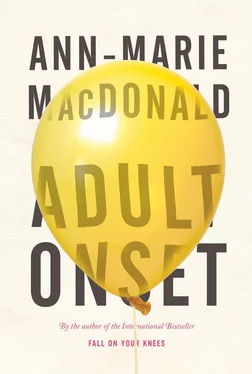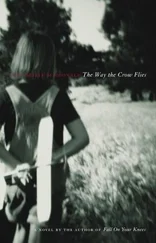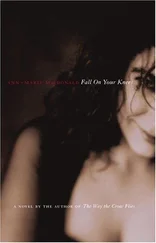The pain dogged her all the way home to Toronto and persisted into the fall. She was about to google it when Hil caught her and laid down the law, “Call Dr. Judy.” So Mary Rose dutifully made an appointment with the family physician. Then, as though the very act of seeking bona fide medical attention had dislodged a suspicion, something began “bothering her at the back of her mind …”
Old memories took on fresh meaning. She recalled Dr. Ferry scolding her mother out in the front hall when she was ten and on her third sling, “… you know what can happen? … what it could be?!” She heard again her mother telling and retelling it as though it were a funny story—“ He really gave me what-for !”—a sure sign, even then, that something was amiss. She saw once more her father’s sealed profile as he walked her down the halls of Radiology, replayed his jaunty tone, “They’re going to snap pictures of your entire skeleton just to make sure there’s no holes anywhere else,” and it dawned on her now: he had been terrified.
Four years after the first operation, she stood with her parents in the surgeon’s consulting room, and saw something else in her mother’s face when the doctor said, “They’ve come back.”
They were living in Ottawa by then, but had driven the two hours to Kingston General Hospital for her twice-yearly checkup — they always went for pizza afterwards and it was nice having her parents to herself. Big Dr. Sorokin stood before the X-ray that was mounted in the light box and tapped with his pencil at the fresh shadows in her humerus. “Here, here and here.”
Her father nodded and compressed his lips. Mary Rose and her mother, in rare emotional unison, turned to face the window — across the way stood the hospital smokestack, drab bricks against the November sky. She saw tears in her mother’s eyes and was shocked to find herself on the verge too, explaining it away inwardly with fourteen-year-old detachment, “I’m not crying, but my body is because it remembers the pain.”
She could not recall ever having seen her mother cry. This was sobering in itself, but there was something else in her mother’s face as she stared out the window. Something grave. Something dignified. Grief.
There was a silver lining to the surgeries: they were the best times with her mother. Dolly was in her element on a hospital ward, the only person who made Mary Rose feel safe — her face, her voice, made even the pain fresh and sane. Especially the last time when, at fourteen, Mary Rose knew enough to worry the surgeon might make a mistake.
“It’s the left arm, the one with the scar already,” she told them as they shifted her from the gurney to the operating table. They appeared not to have heard. They were wearing masks. A big light was suspended over her. Everything was clattery and steel, the doctor’s forearms were hairy but his hands were chalky white. She could not move, but she could talk. They had given her a needle out in the hallway where she’d been parked among the other gurneys like aircraft lined up on the tarmac. A nurse had come along and jabbed it into her thigh without warning. The drug splintered painfully into her bloodstream. Mary Rose asked, “What is that?” “It’ll calm you down,” answered the nurse. She had already been calm, but now she became anxious as her limbs filled up with wet concrete. Time blinked and blanked and jumped, then it was her turn to take off. They wheeled her into the O.R. under the interrogation lights and slipped the point of a finer needle into the back of her hand — its syringe-body rested against her skin like a patient insect. Before the anaesthetic doused her with black, she said, “Don’t cut it off.” She may have heard a laugh.
She had also known enough to realize she might not wake up. “That’s a virtual impossibility,” her father had reassured her with his incredulous chuckle. At fourteen, however, Mary Rose did not like the “virtual.”
As she lay recovering, Dolly would breeze in, all Broadway in her leopard print tam and matching coat. Everyone else, even her father, made Mary Rose very tired. She would smile and make it okay, but Mum would sweep in, call the nurses by name and get fresh sheets under her. Dolly found the bedsores forming on Mary Rose’s heels and elbows and got her to sit up. “That’s it, now rotate your feet around your ankles, open and close your fists, that’s right, keep moving.” It was possible to get gangrene from lying still. Dolly got her to breathe deeply so she wouldn’t get pneumonia. “That’s it, take a big drink of air. Now let it all out again.” It was possible to die of lying down.
The nurses loved Dolly, she was one of them, and they were nicer to Mary Rose as a result. Except for the night nurse, who hadn’t met her mother.
Last fall when the pain in her arm failed to go away, the thing that was bothering her at the back of her mind came to the fore: she began to wonder if her parents had known something about her arm that they had never told her. What if they had not been benign pediatric bone cysts? What if she had actually had pediatric bone cancer and her parents kept it from her because everything had turned out fine? She needed to know, because what if it recurred? She needed to know, because … it was her story, and if it was being held hostage by her parents, she had to get it back. So no sooner had she made the appointment with Dr. Judy, than she redialled and asked the receptionist to requisition her medical records from Kingston General Hospital, where she had undergone both bone grafts.
It was a Tuesday morning, just like today, a child-care morning early last fall, when she sat in Dr. Judy Farber’s examination room, averting her gaze from anything too clinical such as swabs and hypodermics, focusing on the cheery oven mitts bedecking the stirrups. Still, her stomach went cold as she watched Judy open the large brown envelope and scan the few photocopied pages before reading aloud, “ ‘Benign pediatric bone cysts.’ ”
“That’s all?”
“What were you expecting?”
“Cancer?”
Hypochondriac. Think of all the people with actual cancer, meanwhile here she was sniffing about for tumours like a toxic truffle pig.
“Definitely not.”
This was, of course, good news and she tucked her tail neatly between her legs and rose to depart Judy’s office, conscious of her debt to that mythical beast, “the taxpayer,” who had funded her flight of fancy, chastening herself for overdramatizing like the flaky artist-type she was. Wanting her special arm to be that much more special.
“Wait, what about the pain?”
“Oh yeah, I forgot,” said Mary Rose.
“That’s why you’re here.”
Judy had her remove her top, and palpated the arm, the bone … a creepy feeling but not exactly painful.
“Can they come back?”
“Of course not.”
“Good.” Nothing is more reassuring than having your fears scoffed at by a physician.
But Judy added, “Why am I saying that? I actually don’t know for sure. If you’re worried I can refer you to an orthopaedic surgeon.”
“Are you worried?”
“No. But I err on the side of caution.”
Dr. Judy referred her to a specialist, and one balmy October morning a few Tuesdays later, she left Maggie with Candace and headed off on her bike. This time she cycled down through rapidly gentrifying Kensington Market to Toronto Western Hospital on Bathurst Street across from Balloon King, where jaunty skeletons cavorted with witches and pumpkins in the window. She locked her bike outside Emergency and removed her jacket. “Unseasonably warm.” When would we dispense with denial? As though Earth were merely having a bad hair day.
She waited in Radiology, but she had brought a book, The Brain That Changes Itself , and naturally her arm felt perfectly fine.
Читать дальше












